Archive of Carex, Doyenne of the Grass Folk.
Anyone who lives in the Grassland should understand its inhabitants. Carex is not only Mistress and Protector of the Green Shadows, but also has a masterful knowledge of the creatures of the Grassland, their strengths, weaknesses, and their behavior over the course of the seedings.
-
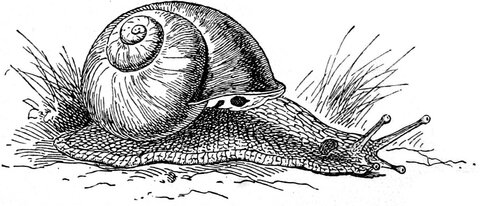
Roman Snail (Helix pomatia)
The Roman snail is the largest land snail of the Grassland and very rare this far north, as Carex notes. It is site-faithful and is found in shrubberies and sparse forests. It can reach an age of more than eight years and can climb very well. The snail is helped in this by its mucus, which enables it to crawl vertically up walls. It also protects it from injuries and dehydration.
The animal has an eye at the end of each of its two long, upper antennae. With the lower antennae it feels and tastes. The snail cannot hear. It feeds on soft, withered plant parts and algae.
The snails spend the winter in cold torpor. During severe drought in the summer, Roman snails can also dry sleep.
-
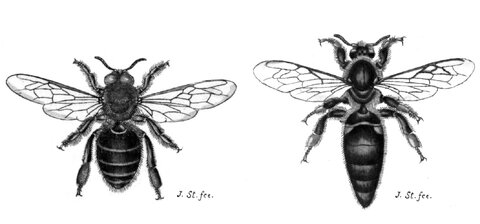
Western Honey Bee (Apis mellifera)
The wild honeybees of the Grassland live in hollow trees, so-called “bee trees”. They form large colonies, the bee states, which reach their maximum at the summer solstice with 40,000 to 60,000 animals.
The community of bees is called “Bien”. The Bien is a superorganism that possesses abilities not mastered by the individual bee. Although bees as insects are cold-blooded animals, as a community they can maintain the group permanently like a warm-blooded animal by regulating the heat in the hive by flapping their wings together.
There are three types of bees: the queen as the mother of the colony and the only sexually mature female that lays the eggs, the smaller workers, and the male drones. The illustration shows a male drone on the left, and a female worker on the right.
-
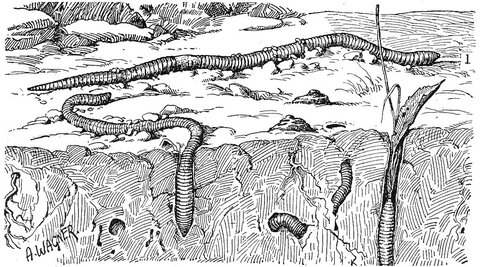
Common Earthworm (Lumbricus terrestris)
The common earthworm, also known as the dew worm, is the largest and most widespread earthworm species in the Grasslands, with a body length of up to 35 centimeters. It continues to grow throughout its life by forming more segments at its rear end.
After about a year, the common earthworm becomes sexually mature. Then, from the second to the eighth moon, a lighter colored and thickened girdle is visible in its front third of the body. The young hatch out of the cocoons after one year at the latest.
Earthworms live in Grassland meadows and burrow the soil intensively, digging tunnels up to three meters deep. They feed on dead plant parts, which they pull into their living tubes and digest there. The droppings are deposited as heaps on the surface. As a particularly loose and humus-rich soil, the Grass People use it as fertilizer when sowing the annual seeding.
-
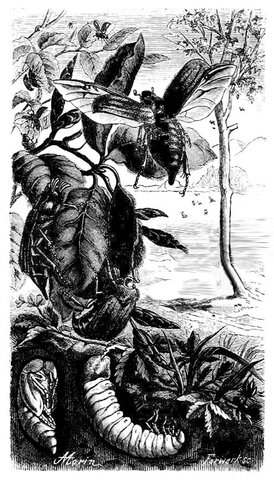
Common Cockchafer (Melolontha melolontha)
Common cockchafers are found throughout the Grassland. Unlike forest cockchafers, they prefer open habitats. Their larvae, the grubs, live burrowed in the soil and prefer to feed on the roots of dandelion, meadow fescue, dock and yarrow. They are whitish-yellow in color, carry three pairs of strong legs, and have powerful, highly visible biting tools.
After four years, the grubs have completed their development into cockchafers and burrow out of the ground in the fourth and fifth moon. They then prefer to eat oak and beech leaves. Their flight occurs almost exclusively at dusk.
Mating, which can last several hours, takes place on forage trees. The males die afterwards, the females lay their eggs first. To do this, they burrow into soft ground up to 25 centimeters deep. The grubs hatch from their two clutches after four to six weeks. They crawl through the soil in search of roots. In winter, the larvae burrow deeper into the soil to escape frosts.
-

Red Wood Ant (Formica rufa)
The red wood ant colony lives in the deciduous forest in the southeast of the Grassland. At the edge of the forest and in clearings, it builds its mounds from twigs and leaves, which are populated by up to two million ants. They serve the animals as storage reservoirs as well as breeding sites for their larvae and can be three meters tall.
The red wood ant is characterized by its powerful mouthparts. With these, it bites its enemy and injects acid into the wound. In search of food, red wood ants never move more than fifty meters from the burrow. They follow ant trails, which they mark with pheromones. The animals also have a magnetic sense. They feed on insects, larvae, arachnids, carrion, honeydew of aphids, and sap from trees and fruits.
There is a distinct division of labor in the ant colony. One finds different forms of ants adapted to their respective tasks, called castes. These include the workers, the soldiers, the winged males, and one or more queens, which can live up to 20 years.
-
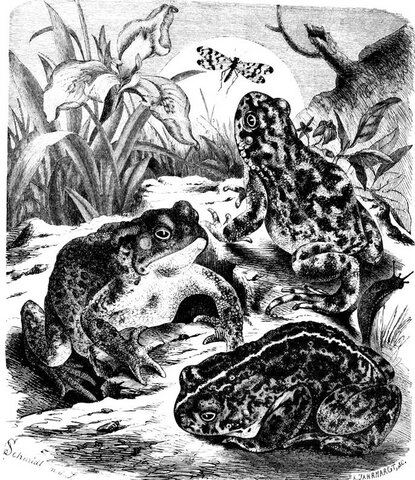
Common Toad (Bufo bufo)
Common toads are not rare in the Grassland and are famous for their beautiful golden eyes. They spend the day hiding under stones, leaves or dead branches. At night they go hunting and capture worms, snails and various insects. Motionless animals are not noticed by the toads.
In the Spring, usually in the third moon, the Grassland toads leave their winter quarters en masse and migrate to the ponds in the southeast of the Great Plain, which they use as spawning grounds. After mating, they lay their eggs there in the form of strings that they wrap around branches and aquatic plants underwater. The spawn develops into tadpoles after several days. After about two and a half to three moons, the tadpoles turn into young toads and often go to shore in large numbers at the same time.
The skin glands of the common toad produce a toxic secretion to ward off enemies. It increases blood pressure and paralyzes movement. Toad poisons are the longest known animal poisons and were used as remedies in ancient times.
The picture shows from left to right: common toad (Bufo bufo), green toad (Bufo virides) and natterjack toad (Bufo calamita).